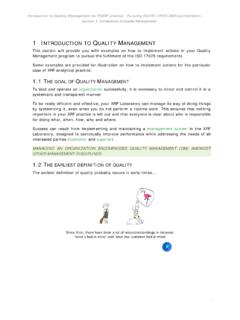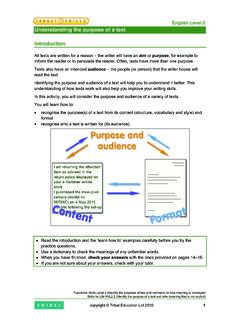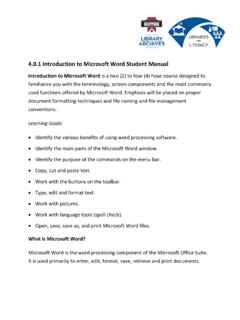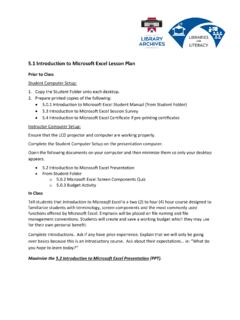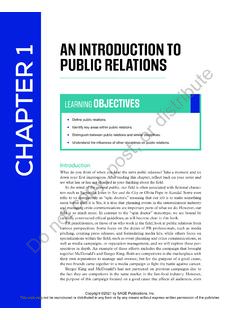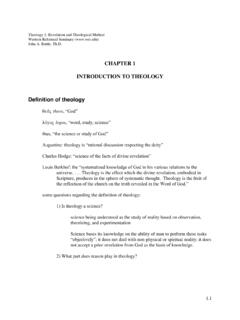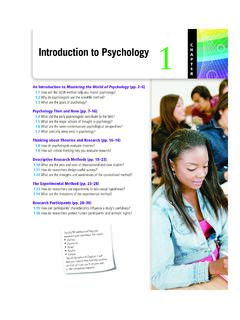Transcription of Introduction The Purpose of Assessment
1 HomeA Primer: Diagnostic, Formative, & Summative AssessmentRich ard Swearin g en , Heritag e Un iv ers ity , 2002 IntroductionAccording to Kellough and Kellough, "Teaching and learning are reciprocal processes thatdepend on and affect one another. Thus, the Assessment component deals with how wellthe students are learning and how well the teacher is teaching" (1999, p. 417). It is the" Assessment component" of teaching and learning that this paper will address. Inparticular, the distinctions between diagnostic, formative, and summative assessmentmethods will be Purpose of AssessmentBefore addressing the different types of Assessment , it is instructive to delineateassessment s purposes. Kellough et al (p. 418-419) characterizes seven purposes ofassessment:To assist student identify students strengths and assess the effectiveness of a particular instructional assess and improve the effectiveness of curriculum assess and improve teaching provide data that assist in decision makingTo communicate with and involve That Guide Good AssessmentAccording to Kellough et al (1999):Because the welfare and, indeed, the future of so many people depend on theoutcomes of Assessment , it is impossible to overemphasize its importance.
2 Fora learning endeavor to be successful, the learner must have answers to basicquestions: Where am I going? Where am I now? How do I get where I amgoing? How will I know when I get there? Am I on the right track for gettingthere? These questions are integral to a good program of Assessment (pg. 419).6/30/2010A Primer: Diagnostic, Formative, & view of such questions, it is requisite to establish principles that will guide Assessment simplementation. Towards such an end, the American Association for Higher Education(AAHE) has established the following nine principles (Pausch & Popp, 1997, Assessmentin Higher Education, 1):The Assessment of student learning begins with educational is most effective when it reflects an understanding of learning asmultidimensional, integrated, and revealed in performance over works best when the programs it seeks to improve have clear, explicitlystated requires attention to outcomes but also and equally to the experiencesthat lead to those works best when it is ongoing, not fosters wider improvement when representatives from across theeducational community are makes a difference when it begins with issues of use and illuminatesquestions that people really care about [sic].
3 Assessment is most likely to lead to improvement when it is part of a larger set ofconditions that promote Assessment [sic] educators meet responsibilities to AssessmentHaving defined the Purpose and principles that drive Assessment , this paper s focus willshift to distinguishing the different types of Assessment , beginning with some authors delineate diagnostic Assessment as a component of formativeassessment, most consider it a distinct form of measurement (Kellough et al, 1999;McMillan, 2000). In practice, the Purpose of diagnostic Assessment is to ascertain, prior toinstruction, each student s strengths, weaknesses, knowledge, and skills. Establishingthese permits the instructor to remediate students and adjust the curriculum to meet eachpupil s unique example, the Heritage College Mathematics Department administers a diagnostic testto all Math 98, 99, and 101 students during the first week of each new semester.
4 Math 98students take an exam that covers Math 97 material; Math 99 students take one thatcovers Math 97 and 98 materials; and Math 101 students take one that covers Math 97,6/30/2010A Primer: Diagnostic, Formative, & , and 99 materials. Based on the diagnostic exam results, each student s deficiencies aredetermined, and each student is subsequently required to complete a computer-basedmathematics tutorial program that is tailored to his or her specific difficulties. Because theprimary Purpose of the diagnostic test is remediation, it is both un-graded and AssessmentAccording to the NCTM s Principles and Standards for School Mathematics (2000): Assessment should be more than merely a test at the end of instruction to seehow students perform under special conditions; rather, it should be an integralpart of instruction that informs and guides teachers as they make instructionaldecisions.
5 Assessment should not merely be done to students; rather, it shouldalso be done for students, to guide and enhance their learning (The AssessmentPrinciple, 1). Assessment of the type broached in the preceding excerpt is known as formativeassessment. Formative Assessment should occur regularly throughout the instructionalprocess and, According to the National Center for Fair and Open Testing (NCFOT)(1999), it "occurs when teachers feed information back to the students in ways that enablethe student to learn better, or when students can engage in a similar, self-reflectiveprocess" ( 4). In its purist form, formative tests are not graded and are used as anongoing diagnostic tool; hence, the instructor employs the results of formative assessmentsolely to modify and adjust his or her teaching practices to reflect the needs and progressof his or her students.
6 However, formative Assessment in its purist form is seldom used(Brookhart, 1999), a fact which led the NCFOT to conclude, "Most teachers do not knowwell how to engage in such Assessment " ( 5).Nevertheless, there is research evidence that indicates the efficacy of formativeassessment. For example:Black and William report that studies of formative Assessment show an effectsize on standardized tests of between and , larger than most knowneducational interventions. (The effect size is the ratio of the averageimprovement in test scores in the innovation to the range of scores of typicalgroups of pupils on the same tests.. Formative Assessment is particularlyeffective for students who have not done well in school, thus narrowing thegap between low and high achievers while raising overall achievement(NCFOT, 1999, 4).)
7 Hence, if indeed "the primary Purpose of Assessment is to support high-quality learning"(NCFOT, 1999, 3), it is incumbent upon individual educators to investigate formativeassessment practices and their classroom Assessment6/30/2010A Primer: Diagnostic, Formative, & final type of Assessment that this essay addresses is the summative Assessment . Black(1998, as cited by Brookhart, 1999), explaining summative Assessment via analogy,stated, "When the cook tastes the soup, that s formative Assessment ; when the customertastes the soup, that s summative Assessment " (Formative and Summative, 1).Succinctly, summative Assessment is a test, usually given at the end of a term, chapter,semester, year, or the like, the Purpose of which is evaluative; in addition, high-stakestests such as ACT, GRE, SAT, and the WASL are also examples of "quality summative information can.
8 Shape how teachers organize theircourse, shape how teachers organize their courses or what schools offer their students"(NCFOT, 1999, 3), there is evidence that summative assessments, such as standardizedexams, can adversely affect students (Phi Delta Kappan, October 1998, as cited byNCFOT, 1999). Nevertheless, especially given the current, artificially stratified, nature ofthe K-12 system, summative Assessment is unavoidable. Hence, it is incumbent uponeducators to minimize any adverse effects that such Assessment might have on order to maximize the efficacy of summative (and formative) Assessment , the followingfactors must be considered: authenticity (Brookhart, 1999; Kellough et al, 1999), variety(Kellough et al, 1999; NREL, 2000), volume (Kellough, 1999; NCFOT, 1999), validity(Brookhart, 1999; Kellough, 1999), and reliability (Kellough, 1999).
9 AuthenticityAssessment that is aligned with the classroom objectives and that reflects real-worldapplications is called authentic Assessment . In providing examples of authentic Assessment ,Kellough et al (1999) wrote that:In English/language arts .. although it may seem fairly easy to develop acriterion-referenced test, administer it, and grade it, tests often measurelanguage skills rather than language use. It is extremely difficult to measurestudents communicative competence with a test.. An authentic assessmentof punctuation, then, would be an Assessment of a performance item thatinvolves students in writing and punctuating their own writing. For theauthentic Assessment of the student s understanding of that which the studenthas been learning, you would use a performance-based Assessment procedure,that is, a procedure that requires students to produce rather than to select method of insuring quality Assessment is to use a variety of assessmenttechniques.
10 Traditionally, true/false and selected-response test items have been popular6/30/2010A Primer: Diagnostic, Formative, & of assessing students. However, these are limited in scope and typically test eachstudent s capacity for rote memorization. However, Assessment should include all threedomains of learning; cognitive, affective, and psychomotor; in addition, assessments ofthe cognitive domain should reflect, at least partially, its higher levels, such as synthesisand evaluation. Hence, instructors should use a variety of Assessment techniques, such asportfolios, cooperative research projects, papers, and performance , in addition to permitting an instructor to assess each of the domains of learning, isalso a method for minimizing Assessment bias against at-risk groups. For example,"Decoding the language of a paper-and-pencil test can hinder language-minority studentsfrom demonstrating what they know.
